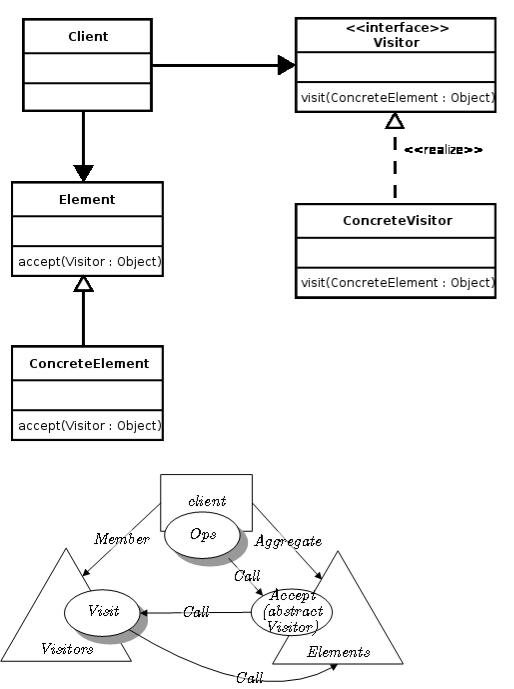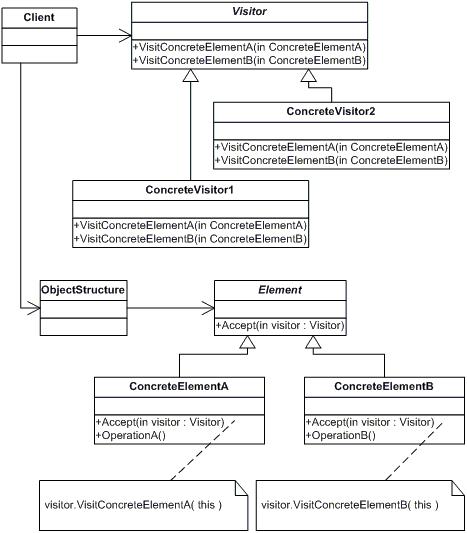
- •Вступление
- •Порождающие шаблоны проектирования
- •Использование
- •Перечень порождающих шаблонов
- •Абстрактная фабрика — Абстрактная фабрика
- •Цель
- •Плюсы
- •Минусы
- •Применимость
- •Структура
- •Пример реализации
- •Builder — Строитель
- •Цель
- •Плюсы
- •Применение
- •Структура
- •Пример реализации
- •Factory method — Фабричный метод
- •Цель
- •Структура
- •Плюсы
- •Минусы
- •Пример реализации
- •Lazy initialization — Ленивая инициализация
- •Достоинства
- •Недостатки
- •Пример реализации
- •Object pool — Объектный пул
- •Применение
- •Переполнение
- •Примеры
- •Ловушки
- •Пример реализации
- •Prototype — Прототип
- •Назначение
- •Применимость
- •Структура
- •Пример реализации
- •Singleton — Одиночка
- •Цель
- •Плюсы
- •Минусы
- •Применение
- •Структура
- •Пример реализации
- •Double checked locking - Блокировка с двойной проверкой
- •Пример реализации
- •Структурные шаблоны проектирования
- •Использование
- •Перечень структурных шаблонов
- •Front Controller — Входная точка
- •Пример
- •Структура
- •Adapter — Адаптер
- •Задача
- •Способ решения
- •Участники
- •Структура
- •Следствия
- •Реализация
- •Пример реализации
- •Bridge — Мост
- •Цель
- •Структура
- •Описание
- •Использование
- •Пример реализации
- •Composite — Компоновщик
- •Цель
- •Структура
- •Пример реализации
- •Decorator — Декоратор
- •Задача
- •Способ решения
- •Участники
- •Следствия
- •Реализация
- •Замечания и комментарии
- •Применение шаблона
- •Структура
- •Пример реализации
- •Facade — Фасад
- •Структура
- •Проблема
- •Решение
- •Особенности применения
- •Пример реализации
- •Flyweight — Приспособленец
- •Цель
- •Описание
- •Сруктура
- •Пример реализации
- •Proxy — Заместитель
- •Проблема
- •Решение
- •Структура
- •Преимущества
- •Недостатки
- •Сфера применения
- •Прокси и близкие к нему шаблоны
- •Пример реализации
- •Поведенческие шаблоны проектирования
- •Использование
- •Перечень поведенческий шаблонов
- •Chain of responsibility — Цепочка обязанностей
- •Применение
- •Сруктура
- •Пример реализации
- •Command — Команда
- •Цель
- •Описание
- •Сруктура
- •Пример реализации
- •Interpreter — Интерпретатор
- •Проблема
- •Решение
- •Преимущества
- •Недостатки
- •Пример
- •Структура
- •Пример реализации
- •Iterator — Итератор
- •Структура
- •Пример реализации
- •Mediator — Посредник
- •Проблема
- •Решение
- •Преимущества
- •Структура
- •Описание
- •Пример реализации
- •Memento — Хранитель
- •Применение
- •Структура
- •Описание
- •Пример реализации
- •Observer — Наблюдатель
- •Назначение
- •Структура
- •Область применения
- •Пример реализации
- •State — Состояние
- •Структура
- •Пример реализации
- •Strategy — Стратегия
- •Задача
- •Мотивы
- •Способ решения
- •Участники
- •Следствия
- •Реализация
- •Полезные сведения
- •Использование
- •Сруктура
- •Пример реализации
- •Template — Шаблонный метод
- •Применимость
- •Участники
- •Сруктура
- •Пример реализации
- •Visitor — Посетитель
- •Структура
- •Описание средствами псевдокода
- •Проблема
- •Решение
- •Рекомендации
- •Преимущества
- •Недостатки
- •Пример реализации
- •Null Object (Null object)
- •Мотивация
- •Описание
- •Структура
- •Реализация
- •Пример
- •Связь с другими патернами
- •Критика и комментарии
- •Пример реализации
- •Слуга (Servant)
- •Описание
- •Структура
- •Реализаци
- •Пример реализации
- •Specification (Specification)
- •Структура
- •Пример реализации
- •Пример использования
- •Simple Policy
- •Обзор
- •Простыми словами
- •Сруктура
- •Пример реализации
- •Single-serving visitor
- •Применение
- •Пример использования
- •Плюси
- •Минусы
- •Пример реализации
- •Об авторе

Visitor — Посетитель
Шаблон Посетитель (Visitor) — поведенческий Шаблон проектирования.
Описывает операцию, которая выполняется над объектами других классов. При изменении Visitor нет необходимости изменять обслуживаемые классы.
Структура
Описание средствами псевдокода interface Obj
{
void visit(Visitor visitor, params);
}
interface Visitor
{
106
void visitA(A a, params); void visitB(B b, params);
}
class A implements Obj
{
void visit(Visitor visitor, params) { visitor.visitA(this, params); }
}
class B implements Obj
{
void visit(Visitor visitor, params) { visitor.visitB(this, params); }
}
class Visitor1 implements Visitor
{
void visitA(A a, params); void visitB(B b, params);
}
class Visitor2 implements Visitor
{
void visitA(A a, params); void visitB(B b, params);
}
Проблема
Над каждым объектом некоторой структуры выполняется одна или более операций. Определить новую операцию, не изменяя классы объектов.
Решение
Для полной независимости посетители имеют отдельную от обслуживаемых структур иерархию. Структуры должны иметь некий интерфейс взаимодействия. При необходимости добавления новых операций необходимо создать новый класс ConcreteVisitor и поместить его в цепочку обхода обслуживаемых структур.
Рекомендации
Шаблон «Посетитель» следует использовать, если:
-в структуре присутствуют объекты разных классов с различными интерфейсами, и необходимо выполнить над ними операции, зависящие от конкретных классов.
-если над обслуживаемой структурой надо выполнять самые различные, порой не связанные между собой операции. То есть они усложняют эту структуру.
-часто добавляются новые операции над обслуживаемой структурой.
-реализация double dispatch. Концептуально это нечто вроде {a; b} -> method(params), где реально вызываемый по стрелочке метод зависит как от типа a, так и от типа b. Так как большинство объектноориентированных языков программирования не поддерживает такое на уровне синтаксиса, для такого обычно применяется Visitor в виде a -> visit(b, params), который в свою очередь вызывает b -> visitA(a, params), что дает выбор и по типу a, и по типу b.
Преимущества
-упрощается добавление новых операций
-объединяет родственные операции в классе «Посетитель».
107

- экземпляр визитора может иметь в себе состояние (например, общую сумму) и накапливать его по ходу обхода контейнера.
Недостатки
Затруднено добавление новых классов, поскольку требуется объявление новой абстрактной операции в интерфейсе визитора, а значит — и во всех классах, реализующих данный интерфейс.
Пример реализации
The classes and/or objects participating in this pattern are:
Visitor (Visitor) declares a Visit operation for each class of ConcreteElement in the object structure. The operation's name and signature identifies the class that sends the Visit request to the visitor. That lets the visitor determine the concrete class of the element being visited. Then the visitor can access the elements directly through its particular interface
ConcreteVisitor (IncomeVisitor, VacationVisitor) implements each operation declared by Visitor. Each operation implements a fragment of the algorithm defined for the corresponding class or object in the structure. ConcreteVisitor provides the context for the algorithm and stores its local state. This state often accumulates results during the traversal of the structure.
Element (Element) defines an Accept operation that takes a visitor as an argument.
108
ConcreteElement (Employee) implements an Accept operation that takes a visitor as an argument
ObjectStructure (Employees) can enumerate its elements
may provide a high-level interface to allow the visitor to visit its elements
may either be a Composite (pattern) or a collection such as a list or a set
This structural code demonstrates the Visitor pattern in which an object traverses an object structure and performs the same operation on each node in this structure. Different visitor objects define different operations.
// Visitor pattern -- Structural example
using System;
using System.Collections.Generic;
namespace DoFactory.GangOfFour.Visitor.Structural
{
///<summary>
///MainApp startup class for Structural
///Visitor Design Pattern.
///</summary>
class MainApp
{
static void Main()
{
// Setup structure
ObjectStructure o = new ObjectStructure(); o.Attach(new ConcreteElementA()); o.Attach(new ConcreteElementB());
// Create visitor objects
ConcreteVisitor1 v1 = new ConcreteVisitor1(); ConcreteVisitor2 v2 = new ConcreteVisitor2();
//Structure accepting visitors o.Accept(v1);
o.Accept(v2);
//Wait for user
Console.ReadKey();
}
}
///<summary>
///The 'Visitor' abstract class
///</summary>
abstract class Visitor
{
public abstract void VisitConcreteElementA( ConcreteElementA concreteElementA);
public abstract void VisitConcreteElementB( ConcreteElementB concreteElementB);
}
///<summary>
///A 'ConcreteVisitor' class
///</summary>
class ConcreteVisitor1 : Visitor
{
public override void VisitConcreteElementA(ConcreteElementA concreteElementA)
{
109
Console.WriteLine("{0} visited by {1}", concreteElementA.GetType().Name, this.GetType().Name);
}
public override void VisitConcreteElementB(ConcreteElementB concreteElementB)
{
Console.WriteLine("{0} visited by {1}", concreteElementB.GetType().Name, this.GetType().Name);
}
}
///<summary>
///A 'ConcreteVisitor' class
///</summary>
class ConcreteVisitor2 : Visitor
{
public override void VisitConcreteElementA(ConcreteElementA concreteElementA)
{
Console.WriteLine("{0} visited by {1}", concreteElementA.GetType().Name, this.GetType().Name);
}
public override void VisitConcreteElementB(ConcreteElementB concreteElementB)
{
Console.WriteLine("{0} visited by {1}", concreteElementB.GetType().Name, this.GetType().Name);
}
}
///<summary>
///The 'Element' abstract class
///</summary>
abstract class Element
{
public abstract void Accept(Visitor visitor);
}
///<summary>
///A 'ConcreteElement' class
///</summary>
class ConcreteElementA : Element
{
public override void Accept(Visitor visitor)
{
visitor.VisitConcreteElementA(this);
}
public void OperationA()
{
}
}
///<summary>
///A 'ConcreteElement' class
///</summary>
class ConcreteElementB : Element
{
public override void Accept(Visitor visitor)
{
visitor.VisitConcreteElementB(this);
}
public void OperationB()
{
}
110
}
///<summary>
///The 'ObjectStructure' class
///</summary>
class ObjectStructure
{
private List<Element> _elements = new List<Element>();
public void Attach(Element element)
{
_elements.Add(element);
}
public void Detach(Element element)
{
_elements.Remove(element);
}
public void Accept(Visitor visitor)
{
foreach (Element element in _elements)
{
element.Accept(visitor);
}
}
}
}
Output
ConcreteElementA visited by ConcreteVisitor1
ConcreteElementB visited by ConcreteVisitor1
ConcreteElementA visited by ConcreteVisitor2
ConcreteElementB visited by ConcreteVisitor2
This real-world code demonstrates the Visitor pattern in which two objects traverse a list of Employees and performs the same operation on each Employee. The two visitor objects define different operations -- one adjusts vacation days and the other income.
// Visitor pattern -- Real World example using System;
using System.Collections.Generic;
namespace DoFactory.GangOfFour.Visitor.RealWorld
{
///<summary>
///MainApp startup class for Real-World
///Visitor Design Pattern.
///</summary>
class MainApp
{
///<summary>
///Entry point into console application.
///</summary>
static void Main()
{
//Setup employee collection Employees e = new Employees(); e.Attach(new Clerk()); e.Attach(new Director()); e.Attach(new President());
//Employees are 'visited'
111
e.Accept(new IncomeVisitor()); e.Accept(new VacationVisitor());
// Wait for user Console.ReadKey();
}
}
///<summary>
///The 'Visitor' interface
///</summary>
interface IVisitor
{
void Visit(Element element);
}
///<summary>
///A 'ConcreteVisitor' class
///</summary>
class IncomeVisitor : IVisitor
{
public void Visit(Element element)
{
Employee employee = element as Employee;
// Provide 10% pay raise employee.Income *= 1.10;
Console.WriteLine("{0} {1}'s new income: {2:C}", employee.GetType().Name, employee.Name, employee.Income);
}
}
///<summary>
///A 'ConcreteVisitor' class
///</summary>
class VacationVisitor : IVisitor
{
public void Visit(Element element)
{
Employee employee = element as Employee;
// Provide 3 extra vacation days Console.WriteLine("{0} {1}'s new vacation days: {2}",
employee.GetType().Name, employee.Name, employee.VacationDays);
}
}
///<summary>
///The 'Element' abstract class
///</summary>
abstract class Element
{
public abstract void Accept(IVisitor visitor);
}
///<summary>
///The 'ConcreteElement' class
///</summary>
class Employee : Element
{
private string _name; private double _income;
112
private int _vacationDays;
// Constructor
public Employee(string name, double income, int vacationDays)
{
this._name = name; this._income = income;
this._vacationDays = vacationDays;
}
//Gets or sets the name public string Name
{
get
{
return _name;
}
set
{
_name = value;
}
}
//Gets or sets income public double Income
{
get
{
return _income;
}
set
{
_income = value;
}
}
//Gets or sets number of vacation days public int VacationDays
{
get
{
return _vacationDays;
}
set
{
_vacationDays = value;
}
}
public override void Accept(IVisitor visitor)
{
visitor.Visit(this);
}
}
///<summary>
///The 'ObjectStructure' class
///</summary>
class Employees
{
private List<Employee> _employees = new List<Employee>();
public void Attach(Employee employee)
{
113
_employees.Add(employee);
}
public void Detach(Employee employee)
{
_employees.Remove(employee);
}
public void Accept(IVisitor visitor)
{
foreach (Employee e in _employees)
{
e.Accept(visitor);
}
Console.WriteLine();
}
}
// Three employee types class Clerk : Employee
{
// Constructor
public Clerk() : base("Hank", 25000.0, 14)
{
}
}
class Director : Employee
{
// Constructor
public Director() : base("Elly", 35000.0, 16)
{
}
}
class President : Employee
{
// Constructor
public President() : base("Dick", 45000.0, 21)
{
}
}
}
Output
Clerk Hank's new income: $27,500.00
Director Elly's new income: $38,500.00
President Dick's new income: $49,500.00
Clerk Hank's new vacation days: 14
Director Elly's new vacation days: 16
President Dick's new vacation days: 21
114
